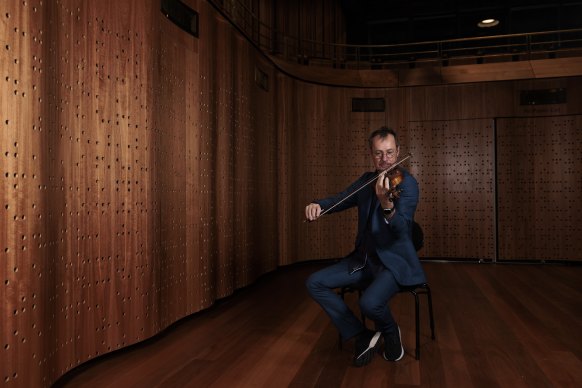This was published 3 years ago
Secret musical messages in Australian Chamber Orchestra’s new home
By Julie Power
If walls could talk. And windows and ceilings. They do in the Australian Chamber Orchestra’s new concert hall, The Neilson, where the surfaces contain secret and coded messages about the power of music.
Written in Braille in the waves of soundproofing in the hall’s walls is a quote by Ludwig van Beethoven: “Kant spoke of the moral law in us, and the starry sky above us. What is music? It is a higher revelation than all wisdom and philosophy.”

Richard Tognetti, the ACO’s chief violinist and artistic director, in the company’s new home.Credit: Brook Mitchell
Quotes written in Morse code and Braille – and references to famous classical musicians written in musical code – are dotted across the ACO’s offices, concert hall and rehearsal spaces at Pier 2/3 at Walsh Bay.
They were a response by Tonkin Zulaikha Greer Architects with sound engineers Arup to the acoustic challenges of housing an orchestra in a 100-year-old wharf with large glass windows overlooking Sydney Harbour.
The indentations of the Braille in the curved panels acted to “sweeten” the reflections from the walls and avoid “acoustic glare”, said Nick Boulter, associate principal with Arup.
In contrast to most concert halls that are housed in windowless boxes, the Neilson is thought to be the only one that provides a fugue with a view.
Secret musical references lurk everywhere.
The gaps in the window glazing were sized according to ratios between the notes of the chords in Bach’s famous Chaconne for solo violin.
There are four different depths, corresponding to the notes Bb, A, C and B natural – spelling BACH in German notation.
This prompted Richard Tognetti, the ACO’s chief violinist and artistic director, to make what he described as a “ridiculous dad pun”.
“Bach is a pane in the glass,” he said.
The depths of the hall’s ceiling use the intervals of the notes in famous music by Shostakovich and Wagner. The spacing helps block out the sound of the harbour, helicopters and ferries outside, as well as improving internal acoustics.
Architect Peter Tonkin said he wanted to make something beautiful from the requirement by the sound engineers to acoustically insulate the rooms from the noise of the harbour while diffusing the sound of the music.
His practice also wanted to make “make buildings with meaning” that the public could relate to on a human scale.
“And with this Morse code, when you know about it, you are very interested,” Tonkin said. “You get this sense of delight and connection to the past. You’ve got to embed joy in these things. It is what life is about. It wasn’t a trivial addition,” he stressed. “It enriches.”
Tognetti said the new concert hall resonated with his dream of having a glass concert hall on the harbour with ferries chugging past.
‘To have these hidden coded messages is a beautiful thing.’
Richard Tognetti
The result of Tonkin’s determination to imbue every detail with the spirit of music and the heritage of the building was like being in a great car.
“You’re not necessarily aware of what’s under the bonnet ... [but] you feel the excellence, the manufacture and the attention to detail.
“I am just so happy that they wanted to bring in these messages. To have these hidden coded messages is a beautiful thing,” Tognetti said.
Not all the quotes are serious. Tognetti’s office features British philosopher John Ruskin talking about Beethoven. Written in Morse code, it says: “Beethoven always sounds to me like the upsetting of a bag of nails, with here and there also a dropped hammer.”
“It is always good to see what people wrote about the masters, or those who ended up as part of the cannon, before they became demi-gods,” Tognetti said.
Boulter said success at the Neilson was characterised as much by “what you don’t hear, as it is by the quality of the music you will hear”.
Two layers of windows, each 31 millimetres thick, and another layer of heritage glass, insulate the concert hall from exterior noise.
Tognetti said the architects spent so much time sound proofing the only sound that comes through is when a helicopter flies low overhead.
He said at the opening festival, filmmaker Jane Campion was holding up her Oscar for The Power of the Dog when a loud party boat with naked strippers went past. The audience could see the strippers but couldn’t hear the noise of the boat. “How rum trade and Sydney is that,” said Tognetti.
Tonkin’s transformation of Walsh Bay’s 100-year-old heritage-listed wharves Pier 2/3 and Wharf 4/5 into a new arts precinct won a National Trust (NSW) Heritage Award for its adaptive reuse. It is also shortlisted for three awards by the NSW chapter of the Australian Institute of Architects to be announced on July 1.
The Morning Edition newsletter is our guide to the day’s most important and interesting stories, analysis and insights. Sign up here.